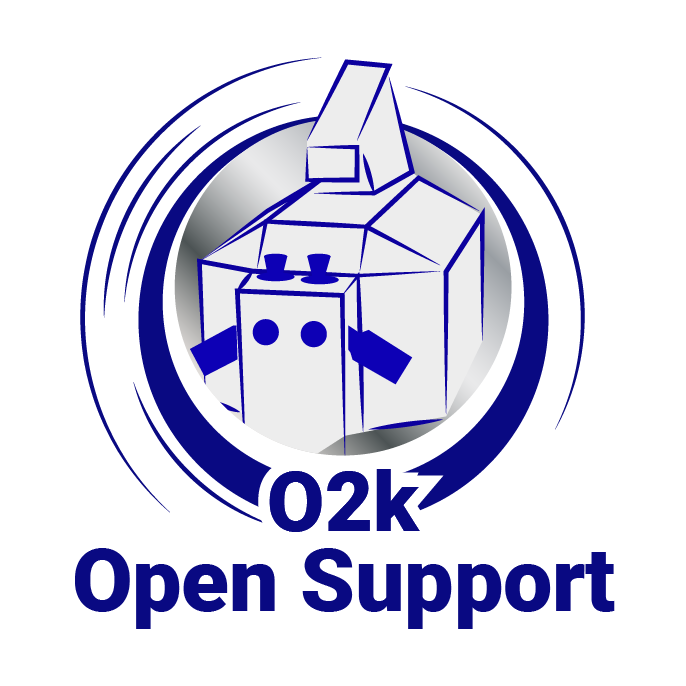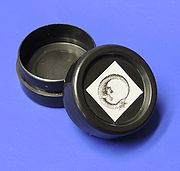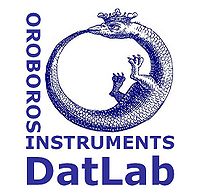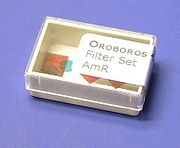OroboPedia topics
| Term | Description |
|---|---|
| 10th European Algae Industry Summit 2020 Reykjavik IS | |
| 10th Int CeBiTec Research Conference 2021 Bielefeld DE | |
| 12th International Conference on Obesity and Eating Disorders 2023 Vienna AT | |
| 12th ÖGMBT Annual Meeting 2020 Virtual Event | |
| 16th Chinese Biophysics Congress 2018 Chengdu CH | |
| 19th Beijing Conference and Exhibition on Instrumental Analysis 2021 Beijing CN | |
| 19th Chinese Biophysics congress 2021 Anhui CN | |
| 1st Myocardial Function Symposium 2020 Graz AT | |
| 1st Workshop on Mitochondrial Functional Diagnostics Innsbruck AT | |
| 2020 PaduaMuscleDays Padua IT | |
| 24th Kalorimetrietage 2021 Braunschweig DE | |
| 2nd Oroboros distributor training 2023 Innsbruck AT | |
| 2nd Workshop on Mitochondrial Functional Diagnostics Innsbruck AT | |
| 46th ISOBM Congress 2019 Athens GR | |
| 4th China Symposium on Nerve Control Metabolism 2021 Hangzhou city CN | |
| 4th edition Metabolism & Cancer 2021 Virtual | |
| 5th edition Metabolism & Cancer 2023 Nice FR | |
| 6th Biannual Meeting on Mitochondria Apoptosis & Cancer 2019 Prague CZ | |
| 7th World Congress on Targeting Microbiota 2019 Krakow PL | |
| 8th SMRM and Mitochondria-Metabolism Network Meeting 2020 Pune IN | |
| ALAS | |
| ALGAEUROPE 2018 Amsterdam NL | |
| AR Buenos Aires Boveris A | |
| ASMRM & J-mit 2019 Fukuoka JP | |
| ASMRM 2017 Xian CN | |
| ASMRM 2018 Busan KR | |
| ASMRM 2021 Singapore SG | |
| AT Graz Graier W | |
| AT Graz Zechner R | |
| AT Innsbruck Burgstaller W | |
| AT Innsbruck Burtscher M | |
| AT Innsbruck Gnaiger E | |
| AT Innsbruck Inncode technologies | |
| AT Innsbruck Jansen-Duerr P | |
| AT Innsbruck MitoFit | |
| AT Innsbruck Oroboros | |
| AT Innsbruck Schneeberger S | |
| AT Kolsass WGT | |
| AT Salzburg Breitenbach M | |
| AT Salzburg Sperl W | |
| AT Vienna Bittner RE | |
| AT Vienna Kozlov AV | |
| AU Chermside Molenaar P | |
| AU Clayton St John J | |
| AU Melbourne Bishop DJ | |
| AU Melbourne Bond S | |
| AU Melbourne Coughlan M | |
| AU Melbourne Hardee JP | |
| AU Melbourne Thouas G | |
| AU Melbourne Trounce IA | |
| AU Melbourne White C | |
| AU Perth Filipovska A | |
| AU Queensland Neuzil J | |
| AU Southport Peart J | |
| AU St Lucia Coombes J | |
| AU Sydney Ballard JW | |
| AU Sydney Griffith SC | |
| AU Sydney James D | |
| AU Sydney Kong S | |
| AU Sydney Philp A | |
| AU Sydney Stocker R | |
| Aasander Frostner 2022 MitoFit | |
| Abbasi 2018 J R Soc Med | |
| Abed Rabbo 2022 MitoFit | |
| Add Graph/Delete bottom graph | Add: A new graph is added at the bottom of the screen. Select plots for display in the new graph, Ctrl+F6. Delete: Delete one of the graphs displayed in DatLab. |
| Alencar 2022 MitoFit | |
| AlgaEurope 2020 Virtual Event | |
| AlgaEurope 2022 Rome IT | |
| All O2k-Workshop | |
| Allahverdiyeva-Rinne Yagut | |
| Amp calibration - DatLab | Amp calibration indicates the calibration of the amperometric O2k-channel. |
| Amperometric,Amp | After selection of the Amperometric, Amp channel in the O2k configuration, an Amperometric, Amp tab will appear in the O2k control [F7] window. Set the desired light intensity (0-1600) in the field ´Fluo intensity´ and the desired amplification of the signal (1-1000) in the field ´Gain for Fluo sensor´in the Amperometric, Amp window followed by a left-click Send to O2k. Switching off the illumination before each fluorometric measurement is routinely required. |
| Analytica China 2020 Shanghai CN | |
| Attached cells | Many cell types are grown in culture as attached cells, such as endothelial or neuronal cells in a monolayer. |
| Automatic pan - DatLab | Automatic pan (only for real-time data recording) toggles automatic panning on/off by clicking in the O2k status line. If it is on (green), the time range is maintained while the time axis always shows the currently recorded data, i.e. the value of the offset (minimum value) increases as experimental time proceeds. If it is off (yellow), the time axis is static. This allows for manually panning backwards to observe previous sections of the experiment at a given time range. In this mode, the actual experimental time may be off-scale. Toggle between "Pan auto" and "Pan off" by a left-click on the text. It does not influence continuous data recording. It is recommended to maintain automatic panning on during the experiment, except for specifically viewing earlier sections of the experiment. |
| Autoscale | Autoscale zooms in or out of the selected period with Autoscale time axis, Autoscale Y1 (Y2) axes and Automatic pan. |
| Autoscale Y1 (Y2) axes | Autoscale Y1 (Y2) axes: Autoscaling the measured values (full data range) on the Y1 (Y2) axis in the selected plot. |
| Autoscale time axis | Autoscale time axis gives an overview of the entire experimental period. |
| Avasthi 2018 eLife | |
| BE Gent Braeckman BP | |
| BE Leuven Spinazzi M | |
| BE Leuven Vermeersch P | |
| BE Liege Sluse F | |
| BE Liege Votion DM | |
| BEC 2020.1 doi10.26124bec2020-0001.v1 | |
| BPS19 2019 Baltimore US | |
| BPS2023 San Diego US | |
| BR Brasilia De Bem AF | |
| BR Campinas Carneiro EM | |
| BR Campinas Castilho R | |
| BR Campinas Vercesi AE | |
| BR Criciuma Dal-Pizzol F | |
| BR Criciuma Muller AP | |
| BR Florianapolis Latini A | |
| BR Jaboticabal Oliveira MT | |
| BR Manaus Val AL | |
| BR Porto Alegre Klamt F | |
| BR Porto Alegre Souza DOG | |
| BR Ribeirao Preto Alberici LC | |
| BR Rio de Janeiro Da Poian AT | |
| BR Rio de Janeiro Galina A | |
| BR Rio de Janeiro Institute Biomedical Chemistry | |
| BR Rio de Janeiro Moura AS | |
| BR Rio de Janeiro Oliveira MF | |
| BR Rio de Janeiro Paes MC | |
| BR Rio de Janeiro Rumjanek FD | |
| BR Rio de Janeiro Vieyra A | |
| BR Santa Maria Soares FA | |
| BR Sao Gabriel Franco JL | |
| BR Sao Paulo Bresciani Martins de Andrade P | |
| BR Sao Paulo Ferreira JCB | |
| BR Sao Paulo Festuccia W | |
| BR Sao Paulo Inada NM | |
| BR Sao Paulo Kowaltowski AJ | |
| BR Sao Paulo Silber AM | |
| Baglivo 2022 MitoFit-QC | |
| Balbaisi 2022 MitoFit | |
| Beno Marija | |
| Berg 2016 Science | |
| Berg 2017 Science | |
| Bhalla 2016 Mol Biol Cell | |
| Bioblast 2012 | |
| Bioblast 2012: Registration and accommodation | |
| Bioblast 2012: Scientific Committee | |
| Bioblast 2022 | |
| Bioblast 2022 - Organisation | |
| Bioblast 2022 - Participants | |
| Bioblast 2022 - Program overview | |
| Bioblast:About | |
| Biological contamination | Biological contamination may be caused by microbial growth in the O2k-Chamber or in the experimental medium. |
| Block temperature | The block temperature of the Oroboros O2k is the continuously measured temperature of the copper block, housing the two glass chambers of the O2k. The block temperature is recorded by DatLab as one of the O2k system channels. |
| Bolivia-Mount Chacaltaya 2012 | |
| Bombaca 2022 MitoFit | |
| Bourne 2017 PLoS Comput Biol | |
| Bove-Fenderson 2018 JBMR Plus | |
| Brown 2020 MitoFit Preprint Arch | |
| CA Antigonish Kane DA | |
| CA Calgary Kinesiology Univ Calgary | |
| CA Calgary Shearer J | |
| CA Chalk River Paterson L | |
| CA Charlottetown Kamunde C | |
| CA Edmonton Lemieux H | |
| CA Edmonton Seubert J | |
| CA Edmonton Zaugg M | |
| CA Guelph Ballantyne JS | |
| CA Guelph Holloway GP | |
| CA Hamilton Scott GR | |
| CA Hamilton Singh G | |
| CA Hamilton Tarnopolsky MA | |
| CA Kelowna Islam H | |
| CA Kingston McGlory C | |
| CA London Staples JF | |
| CA Moncton Boudreau L | |
| CA Moncton Hebert-Chatelain E | |
| CA Moncton Pichaud N | |
| CA Montreal Bergdahl A | |
| CA Montreal Breton S | |
| CA Montreal Gouspillou G | |
| CA Montreal Hepple RT | |
| CA Ottawa Darveau CA | |
| CA Ottawa Harper ME | |
| CA Ottawa Pamenter M | |
| CA Quebec Joseph V | |
| CA Quebec Soliz J | |
| CA Rimouski Blier PU | |
| CA Saint John Pulinilkunnil T | |
| CA Sherbrooke Blondin DP | |
| CA Toronto Bellissimo C | |
| CA Toronto Hood DA | |
| CA Toronto Perry CG | |
| CA Vancouver Boushel RC | |
| CA Vancouver Richards JG | |
| CA Waterloo Joseph JW | |
| CA Waterloo McDonald AE | |
| CA Waterloo Quadrilatero J | |
| CA Winnipeg Banerji V | |
| CA Winnipeg Fernyhough P | |
| CA Winnipeg Treberg JR | |
| CH Basel Balavenkatraman KK | |
| CH Basel Eckert A | |
| CH Basel Kraehenbuehl S | |
| CH Basel Uteng M | |
| CH Bern Djafarzadeh S | |
| CH Bern Longnus SL | |
| CH Bern Nuoffer JM | |
| CH Lausanne Auwerx J | |
| CH Lausanne Bagni C | |
| CH Lausanne Canto C | |
| CH Lausanne EPFL | |
| CH Lausanne Place N | |
| CH Lausanne Sandi C | |
| CH Zurich Gassmann M | |
| CH Zurich Lundby C | |
| CH Zurich University of Zurich Physiology | |
| CH Zurich Wallimann T | |
| CL Santiago Regueira T | |
| CN Baoding Cao X | |
| CN Baoding Liu F | |
| CN Beijing Chen Q | |
| CN Beijing Huawei | |
| CN Beijing Li C | |
| CN Beijing Liu L | |
| CN Beijing Qin Y | |
| CN Beijing Wang X | |
| CN Beijing Yuan Z | |
| CN Chongqing Huang J | |
| CN Chongqing Zhu Z | |
| CN Dalian Zhan L | |
| CN Guangzhou Liu J | |
| CN Guangzhou Zhang X | |
| CN Hangzhou Zhu W | |
| CN Hongkong Huawei | |
| CN Jinan Wang C | |
| CN Macao Huawei | |
| CN Nanjing Gan Z | |
| CN Shanghai Liu T | |
| CN Shanghai Yi X | |
| CN Shanghai Zenda | |
| CN Tianjin Zhang Y | |
| CN Tianjin Zhao H | |
| CN Wuhan Huang K | |
| CN Xiamen Lin SC | |
| CN Zengzhou Wu S | |
| CN Zunyi Zhou S | |
| CO Medellin Gomez LA | |
| CSH Asia 2017 Suzhou CN | |
| CSLMB 2018 Shanghai CN | |
| CU Havana Pardo Andreu GL | |
| CZ Ceske Budejovice Zikova A | |
| CZ Hradec Kralove Cervinkova Z | |
| CZ Olomouc Modriansky M | |
| CZ Pardubice Rousar T | |
| CZ Pilsen Kuncova J | |
| CZ Prague Bioenergetics | |
| CZ Prague Dvorak A | |
| CZ Prague Fisar Z | |
| CZ Prague Houstek J | |
| CZ Prague Jezek P | |
| CZ Prague Kalous M | |
| CZ Prague Kopecky J | |
| CZ Prague Krajcova A | |
| CZ Prague Neuzil J | |
| CZ Prague Pichova A | |
| CZ Prague Zeman J | |
| Calcium | Ca2+ is a major signaling molecule in both prokaryotes and eukaryotes. Its cytoplasmic concentration is tightly regulated by transporters in the plasma membrane and in the membranes of various organelles. For this purpose, it is either extruded from the cell through exchangers and pumps or stored in organelles such as the endoplasmic reticulum and the mitochondria. Changes in the concentration of the cation regulate numerous enzymes including many involved in ATP utilizing and in ATP generating pathways and thus ultimately control metabolic activity of mitochondria and of the entire cell. Measuring changes in Ca2+ levels is thus of considerable interest in the context of high-resolution respirometry. |
| Calcium Green | Calcium GreenTM (CaG) denotes a family of extrinsic fluorophores applied for measurement of Ca2+ concentration with mitochondrial preparations. This dye fluoresces when bound to Ca2+. When measuring mitochondrial calcium uptake it is possible to observe the increase of the CaG signal upon calcium titration, followed by the decrease of CaG signal due to the uptake. |
| Callaway 2013 Nature | |
| Canonical Carol Canon O | |
| Cardoso 2021 MitoFit MgG | |
| Cardoso 2022 MitoFit rTCA | |
| Cardoso Luiza HD | |
| Career Event - FH Campus 2021 Wien AT | |
| Cecatto 2022 MitoFit CaG | |
| Chabi 2019 MitoFit Preprint Arch EA | |
| Chalmers 2016 F1000Research | |
| Channel | » See O2k signals and output |
| Chawla 2017 Nature | |
| Check for updates - DatLab | Check for updates in the Help pull-down menu of DatLab 8 and follow the simple installation instruction if your computer (Linux or Windows) running DatLab is connected to the internet. Alternatively, use a different computer connected to the internet, download the update for Linux, and transfer it to the computer operating DatLab by USB. Check regularly for updates. |
| Chicco 2022 MitoFit | |
| Chinese Academy of pathophysiology, endocrinology and metabolism Specialized Committee Conference 2018 Tianjin CN | |
| Chinopoulos Christos | |
| Chlamy 2021 Ile des Embiez FR | |
| Chlororespiration | In chlororespiration oxygen is consumed by a putative respiratory electron transfer system (ETS) within the thylakoid membrane of the chloroplasts and ATP is produced. It is a process that involves the interaction with the photosynthetic ETS in which NAD(P)H dehydrogenase transfers electrons to oxygen with the assistance of the photosynthetic plastoquinone (PQ), which acts as a non-photochemical redox carrier. Initially described in the unicellular alga Chlamydomonas reindhartdii, chlororespiration was highly disputed for years until the discovery of a NAD(P)H-dehydrogenase (NDH) complex (plastidic encoded) and plastid terminal oxidase (PTOX) (nuclear encoded) in higher-plant chloroplasts. PTOX is homologous to the plant mitochondrial alternative oxidase and has the role of preventing the over-reduction of the PQ pool while the NDH complexes provide a gateway for the electrons to form the ETS and consume oxygen. As a result of this process there is a cyclic electron flow around Photosystem I (PSI) that is activated under stress conditions acting as a photoprotection mechanism and could be involved in protecting against oxidative stress. |
| Citron 2015 Proc Natl Acad Sci U S A | |
| Close and delete file - DatLab | Close and delete file. The decision to delete a DatLab file containing no useful data can be made most easily when viewing the traces. Only available when disconnected from the O2k. |
| Closed chamber | The O2k-chamber can be used as a closed system or open system. Gas bubbles must be avoided. |
| Cobb 2017 PeerJ Preprints | |
| Committee 2018 COPE Discussion Document | |
| Connect to O2k | Connect to O2k connects DatLab with the O2k. Select the USB port (or Serial port) with the corresponding cable connecting your PC to the O2k. Select the subdirectory for saving the DLD file. Then data recording starts with experimental time set at zero. |
| Connection window | After starting DatLab either the Connection window opens automatically by default or open O2k control by pressing [F7] and select the communication port. |
| Copy marks | In Copy marks, Marks in DatLab are copied from a seleted Plot to the active plot. |
| Copy marks - DatLab | |
| Copy to clipboard | In DatLab Copy to clipboard can be used to copy selected graphs or values and to paste them to your preferred program or file (e.g. Word, Excel). |
| Cover-Slip\black | A Cover-Slip should be placed on top of the O2k-Stopper to minimize contamination and evaporation of liquid extruding from the capillary of the stopper. The Cover-Slips do not exert any direct effect on oxygen backdiffusion into the O2k-chamber. Use the the Cover-Slip\black to avoid light penetration and disturbance of fluorescence signals and generally for optical measurements in the O2k. |
| Credit card payment | |
| Crispim 2019 MitoFit Preprint Arch EA | |
| CureMILS | |
| Custom label | A Custom label can be entered in this box to rename the axis label. Two lines are available for the axis name and unit. |
| Custom-made stoppers | Stoppers can be custom-made for applications with user-specific sensors according to customer specifications. |
| Cyclic voltammetry | Cyclic voltammetry (CV) is a type of electrochemical measurement which is applied with the Q-Module as quality control to
(1) determine the oxidation and reduction peak potentials of Coenzyme Q in the specific experimental condition, (2) check the quality of the Q-Sensor, and (3) test the interference of chemicals used in the HRR assay with the Q-Sensor. In CV, the Q-Sensor with the three-electrode system is used to obtain information about the analyte (CoQ) by measuring the current (I) as the electric potential (V) between two of the electrodes is varied. In CV the electric potential between the glassy carbon (GC) and the Ag/AgCl reference electrode changes linearly versus time in cyclical phases, while the current is detected between GC and platinum electrode (Pt). The detected current is plotted versus the applied voltage to obtain the typical cyclic voltammogram trace (Figure 1). The presence of substances that are oxidized/reduced will result in current between GC and Pt, which can be seen as characteristic peaks in the voltammogram at a defined potential. The oxidation or the reduction peak potential values are used to set the GC (integrated into the Q-Sensor) for a separate experiment to measure the Q redox state of a biological sample. The oxidation and reduction peak potentials can be influenced by 1) the respiration medium, 2) the type of CoQ, 3) the polarization window, 4) the scan speed, 5) the number of cycles, 6) the concentration of the analyte (CoQ), and 7) the initial polarization voltage. <be> |
| Cyclic voltammetry - DatLab | Cyclic voltammetry |
| D-A-CH Algen Summit 2024 Bern CH | |
| DE Berlin Boschmann M | |
| DE Biberach Markgraf D | |
| DE Bonn Kunz WS | |
| DE Bonn Pfeifer A | |
| DE Bremerhaven Mark FC | |
| DE Cologne Aging Research | |
| DE Cologne Antebi A | |
| DE Cologne Pesta D | |
| DE Cologne Trifunovic A | |
| DE Duesseldorf Grieshaber MK | |
| DE Duesseldorf Haendeler J | |
| DE Duesseldorf IUF | |
| DE Duesseldorf Ibing W | |
| DE Duesseldorf Roden M | |
| DE Duesseldorf Westenfeld R | |
| DE Essen Bienholz A | |
| DE Essen De Groot H | |
| DE Essen Ferenz K | |
| DE Essen Ferenz KB | |
| DE Essen Gedik N | |
| DE Essen Kirsch M | |
| DE Frankfurt Droese S | |
| DE Frankfurt Eckert GP | |
| DE Frankfurt Leeuw T | |
| DE Frankfurt Osiewacz HD | |
| DE Frankfurt Sanofi | |
| DE Frankfurt Schmoll D | |
| DE Frankfurt Wittig I | |
| DE Freiburg Pfanner N | |
| DE Freiburg Schuele R | |
| DE Freising Klingenspor M | |
| DE Giessen Eckert GP | |
| DE Giessen Rohrbach S | |
| DE Giessen Weissmann N | |
| DE Goettingen Dennerlein S | |
| DE Goettingen Krischek C | |
| DE Goettingen Moerlein D | |
| DE Goettingen Mueller M | |
| DE Goettingen Wicke M | |
| DE Hamburg Heine M | |
| DE Hamburg Singer D | |
| DE Hannover Hildebrandt T | |
| DE Heidelberg Labeit S | |
| DE Heidelberg Mairbaeurl H | |
| DE Heidelberg Teleman A | |
| DE Hottersheim Kabiri M | |
| DE Jena Szibor M | |
| DE Kiel Herdegen T | |
| DE Koblenz Ortmann C | |
| DE Konstanz Brdiczka D | |
| DE Kronshagen Grams B | |
| DE Leipzig Maskow T | |
| DE Leipzig Mueller A | |
| DE Leipzig UFZ Environmental Research | |
| DE Leipzip Ost M | |
| DE Magdeburg Debska-Vielhaber G | |
| DE Magdeburg Gellerich FN | |
| DE Magdeburg Klinik Neurologie | |
| DE Magdeburg Schild L | |
| DE Magdeburg Schoenfeld P | |
| DE Mainz Methner A | |
| DE Munich Elstner M | |
| DE Munich Jastroch M | |
| DE Munich Perocchi F | |
| DE Munich Wollenberg B | |
| DE Munich Zischka H | |
| DE Nuthetal Klaus S | |
| DE Regensburg Reichold M | |
| DE Regensburg Renner-Sattler K | |
| DE Rostock Sokolova I | |
| DE Seewiesen Casagrande S | |
| DE Tuebingen Weigert C | |
| DE Ulm Gumpp A | |
| DE Ulm Karabatsiakis A | |
| DE Ulm Radermacher P | |
| DE Wilhelmshaven Salmon P | |
| DE Wuerzburg Maack C | |
| DK Aarhus Boetker HE | |
| DK Aarhus Fago A | |
| DK Aarhus Martensen PM | |
| DK Copenhagen Christiansen M | |
| DK Copenhagen Dela F | |
| DK Copenhagen Gerhart-Hines Z | |
| DK Copenhagen Larsen AK | |
| DK Copenhagen Larsen S | |
| DK Copenhagen Lundby C | |
| DK Copenhagen Pilegaard H | |
| DK Copenhagen Quistorff B | |
| DK Malov Hey-Mogensen M | |
| Da Silva 2018 Med J Armed Forces India | |
| Dambrova 2022 MitoFit | |
| DatLab | DatLab is the O2k-Software for Data Acquisition & Analysis, specifically developed for high-resolution respirometry with the O2k.
The newest DatLab version is DatLab 8, included in the O2k-Packages. NextGen-O2k and O2k-Series J* and higher come with DatLab 8 installed on the integrated PC (Linux). DatLab 8 is required for the NextGen-O2k. DatLab 8.1 is compatible with O2k-Series (E and higher). The DatLab software is designed for 64-bit versions of Windows operating systems and does not run on MAC devices. The minimum computer requirements are Intel-Core-2 or equivalent CPU, 2GB RAM and Windows XP (64-bit version). However, we recommend Intel i5 or equivalent CPU, 4GB RAM, Windows 10 (64-bit version) and SSD. For the proper display of DatLab on your computer, please make sure the “Language settings” are set to English. *Optionally available without integrated PC. |
| DatLab 2 | DatLab 2 (DL2) is a MS-DOS programe. DL2 is still used for analysis of oxygen kinetics, after exporting files recorded in recent DatLab versions. A user-friendly O2-kinetics module is in preparation (DL8). |
| DatLab 7 | |
| DatLab data file | DatLab 8: The file type generated is *.dld8. DatLab 7: The file type generated is *.DLD. |
| DatLab error messages | Common DatLab error messages and according actions and solutions are listed here. |
| DatLab installation | We recommend a 'clean install' for DatLab installation: rename your previous DatLab programme subdirectory (e.g. C:\DatLab_OLD). The standard Instrumental and SUIT DL-Protocols package is automatically implemented with the simple DatLab programme installation. |
| DatLab oxygen flux: performance and data analysis | The quality of the results are strongly affected by the performance and data analysis. Therefore, we provide guidelines for performing and evaluating respirometric assays. |
| DatLab templates | DatLab templates can be imported for O2k-setups, graph layouts, mark names, TIP2k setups and marks statistics configurations.
|
| DatLab-Analysis templates | Go in DatLab to Mark statistics (F2), select which type of marks you want to export ("All marks in plot" or "DL-Protocol marks", with 3 possibilities each), then click on [Copy to clipboard] to copy selected values and paste them to a DatLab-Analysis template for numerical and graphical data analysis. |
| DatLab-Upgrading to DatLab 6 | DatLab-Upgrading to DatLab 6: including free follow-up updates for DatLab 6 for the next two years |
| DatLab-Upgrading\4.x-5.2 | DatLab-Upgrading\4.1-5.2: Upgrading DatLab 4.x to 5.2, incl. O2k-Manual, with free follow-up updates of DatLab 5.2. Discontinued: see higher DatLab version. |
| Data labels and units - DatLab | |
| Data masks - DatLab | |
| Data recording interval | The data recording interval is the time interval at which data is sampled with an instrument. In DatLab the data recording interval is set in the O2k control window. The system default value is 2 s. A lower data recording interval is selected for kinetic experiments, and when the volume-specific oxygen flux is high (>300 pmol O2·s-1·ml-1). Technically, the O2k instrument (hardware) measures the sensor signal every 10ms (which is NOT the „data recording interval“). By the given data recording interval from DatLab (software) a discrete number of sensor signal points are taken to calculate an average value in the O2k (e.g. a data recording interval of 2 s can take 200 sensor signal points; a data recording interval of 0.5 s can take 50 sensor signal points). This average value is sent to DatLab and is recorded as a raw data point. However, there is a defined threshold: the O2k does not apply more than 200 sensor signal points to calculate the average for the raw data point. For example a data recording interval of 3 s could take 300 sensor signal points but only the 200 most recent sensor signal points are used for averaging. |
| Default label | The Default label is the system default value for the axis label. These labels are changed automatically, according to the selected channel and unit. To change this label enter a Custom label. |
| Delete points | Select Delete points in the Mark information window to remove all data points in the marked section of the active plot. See also Interpolate points and Restore points or Recalculate slope. |
| Deselect channels | Channels can be selected/deselected in DatLab in the O2k configuration. Deselect all O2k-MultiSensor channels in O2k-Core applications. Select only the specifically used channels in O2k-MultiSensor applications. |
| Desjardins-Proulx 2013 PLOS Biol | |
| Development MitoFit proficiency test | |
| Di Marcello 2019 MitoFit Preprint Arch EA | |
| Di Marcello Marco | |
| Die Kraftwerke der Zellen | |
| Different O2 fluxes in left and right chamber | What are potential causes for different O2 fluxes in the left and right chamber? |
| Display DatLab help | Display DatLab help
In this section, we present some issues that could happen during your data analysis related to the graphs display and how to fix them quickly. Case in which an issue might occur:
In the event of a frozen display of the graphs, try the alternatives below:
|
| Display Power-O2k | The Power-O2k number, which is set in the pull-down menu Oroboros O2k \ O2k configuration, is shown in the active graph. To show it in graphs copied to clipboard, the option "Show Oroboros icon in clipboard files" must be enabled in the Graph-menu Graph options - DatLab. |
| Display numerical value | If Display numerical value the current numerical values are displayed in the graph for the active plots on the Y1 axis and Y2 axis (during data acquisition only). |
| Dithionite | The sodium salt of Dithionite Na2S2O4 (Dit) is the 'zero oxygen solution powder' used for calibration of oxygen sensors at zero oxygen concentration, or for stepwise reduction of oxygen concentrations in instrumental O2 background tests. It is not recommended to use dithionite in experiments with biological samples or several multisensor approaches, for these see Setting the oxygen concentration. |
| Doerrier 2019 MitoFit Preprint Arch EA | |
| Doerrier Carolina | |
| Donnelly 2022 MitoFit Hypoxia | |
| EE Tallinn Kaambre T | |
| EE Tallinn Saks VA | |
| EE Tartu Paju K | |
| EE Tartu Seppet EK | |
| EG Cairo Ali SS | |
| ES Barcelona Bosch M | |
| ES Barcelona Claret M | |
| ES Barcelona Garcia-Roves PM | |
| ES Barcelona Gomis R | |
| ES Barcelona IDIBAPS Hospital Clinic | |
| ES Barcelona Moren C | |
| ES Barcelona Zorzano A | |
| ES CN Las Palmas Calbet JAL | |
| ES Granada Acuna-Castroviejo D | |
| ES L'Hospitalet Bermudez MJ | |
| ES Lleida Boada J | |
| ES Madrid Cadenas S | |
| ES Madrid Enriquez JA | |
| ES Madrid Garesse R | |
| ES Malaga Medina MA | |
| ES Pamplona Izquierdo M | |
| ES Santiago De Compostela Mendez-Alvarez E | |
| ES Tarragona Arola L | |
| ES Valencia Casado Pinna M | |
| ES Valencia Gomez Cabrera | |
| ES Valencia Meseguer S | |
| ES Zaragoza Ruiz-Pesini E | |
| ESCI 2021 Virtual | |
| ESP2021 Salzburg AT | |
| Electrolyte\Reference-Electrode | Electrolyte\Reference-Electrode for Reference-Electrode\2.4 mm |
| Electronic-TIP2k Upgrading\O2k-Main Unit Series A-D | Electronic-TIP2k Upgrading\O2k-Main Unit Series A-D - Former Product : not required for O2k-Core, the O2k-Main Unit has to be returned to the OROBOROS workshop. |
| Electronic-TIP2k Upgrading\O2k-Main Unit Series E | Electronic-TIP2k Upgrading\O2k-Main Unit Series E - Former Series : not required for O2k-Core, free of charge for Series E in conjunction with the purchase of the TIP2k-Module, the O2k-Main Unit has to be returned to the OROBOROS workshop. |
| Enable DL-Protocol editing | Enable DL-Protocol editing is a novel function of DatLab 7.4 offering a new feature in DL-Protocols: flexibility. Fixed sequences of events and marks can be changed (Skip/Added) in a SUIT protocol by the user. Moreover, the text, instructions, concentrations and titration volumes of injections in a specific DL-Protocol can be edited and saved as user-specific DL-Protocol [File]\Export\DL-Protocol User (*.DLPU). To enable it, under the 'Protocols' tab in the menu, select the option 'Enable DL-Protocol editing', and then select the plot in which the marks will be set (e.g., O2 flux per V). Select the 'Overview' window, where you will be able to edit events and marks names, definition/state, final concentration and titration volumes, as well as select a mark as 'multi' for multiple titration steps, skip a mark, or add a new event or mark. After saving, export a DL-Protocol User (DLPU) and load it before running the next experiments. If users of DatLab versions older than DatLab 7.4 wish to alter the nature of the chemicals used or the sequence of injections, we ask them to contact the O2k-Technical Support.
For more information:  Export DL-Protocol User (*.DLPU) Export DL-Protocol User (*.DLPU) |
| Events - DatLab | An event in DatLab is a defined point in time, labelled by a name (1 to 10 characters). An event applies to all plots of the selected O2k-Chamber. The event is shown by a vertical line in the graph and the label of the event is shown on the top (DatLab 6 and lower: on the bottom). The default name is the sequential number of the event. It is recommended to edit event labels with a minimum number of characters, and to explain the abbreviation in the 'Definition' box. The final concentration and titration volume can be entered into the corresponding boxes, if the event relates to the titration of a substance. A short comment can be entered to describe the event in detail.
Set events - Manual events are entered (real-time, connected to the O2k) by pressing [F4] at the time of the event (e.g. to indicate a manual titration into the chamber). An event belongs either to chamber A, chamber B, or both. Instrumental events are added automatically, e.g. when the stirrer (A or B) or illumination (both chambers) is switched on or off. After setting a new event the Edit event window pops up. Pressing F4 defines the time point of the event. Full attention can then be paid to the experiment. Edit the event later, as it is possible to insert an event at any chosen moment of the plotted record of the experiment by placing the cursor anywhere in the graph at the selected time point by pressing Ctrl and clicking the left mouse button. Edit event - Left click on the name of an existing event to open the Edit event window to edit or Delete event. In events obtained from a selected protocol, the entire sequence of consecutive events is defined with event names, definitions, concentrations and titration volumes. Name - Enter an event name of 1 to 10 characters. Short names (e.g. O instead of Open) are recommended. Comment - Further information can be entered into the text field. Select O2k-chamber A, B or both. The Event will be shown on plots for both or one selected chamber. »Protocol events |
| Experimental code | An experimental code can be entered in the Sample window, containing up to 10 digits. |
| Experimental log - DatLab | Experimental log provides an automatically generated experimental protocol with detailed information about the O2k settings and calibrations, the Sample information and various Events. Time-dependent information can be viewed for a single chamber or both chambers. The filter can be selected for viewing minimum information, intermittent by default, or all information. The experimental log can be viewed and saved as a PDF file by clicking on [Preview]. |
| Expert/inn/en-Workshop Medizintechnik Innsbruck AT | |
| Export DL-Protocol User (*.DLPU) | it is a function of DatLab (available from version 7.4 onwards) that enables the export of user specific protocols (DL-Protocol User) to the SUIT protocol folder from which they can be uploaded for subsequent measurements. |
| Extended abstracts | In the context of MiPevents, extended abstracts are accepted for preprint publication in MitoFit Preprints upon evaluation by the MitoFit Preprints Scientific Advisory Board. Publishing extended abstracts with MitoFit Preprints does not preclude later full journal publication, but will make your work fully citable, by assigning each manuscript a unique DOI number, and facilitate discovery and feedback. |
| FAT4BRAIN | |
| FEBS 2019 Krakow PL | |
| FEBS Workshop Ageing 2019 Innsbruck AT | |
| FEMtech Internship for students | |
| FI Helsinki Jacobs HT | |
| FI Helsinki Mervaala E | |
| FI Helsinki Pirinen E | |
| FI Helsinki University of Helsinki | |
| FI Helsinki Wartiovaara A | |
| FI Helsinki Wikstroem M | |
| FI Jyväskylä Kainulainen H | |
| FI Oulu Kastaniotis A | |
| FI Tampere Dufour E | |
| FI Turku Nikinmaa M | |
| FR Angers Andriantsitohaina R | |
| FR Angers Gueguen N | |
| FR Aubiere Sirvent P | |
| FR Bordeau Di Rago JP | |
| FR Bordeaux Devin A | |
| FR Bordeaux Mourier A | |
| FR Bordeaux Pagano Zottola A | |
| FR Bordeaux Rossignol R | |
| FR Dijon Leloup C | |
| FR Evry Tardo-Dino PE | |
| FR Fort de France Neviere R | |
| FR Grenoble Saks VA | |
| FR Grenoble Schlattner U | |
| FR La Rochelle Rosenfeld E | |
| FR Lille Boutry M | |
| FR Lille Duez H | |
| FR Lille Lancel Steve | |
| FR Lille Vienne JC | |
| FR Lyon Ovize M | |
| FR Marseille Bioenergetics | |
| FR Marseille Brasseur G | |
| FR Marseille Denis M | |
| FR Marseille Gregori G | |
| FR Montpellier Chabi B | |
| FR Montpellier Fauconnier J | |
| FR Montpellier Prouteau-Angebault C | |
| FR Montpellier Salmon JM | |
| FR Paris Bouillaud F | |
| FR Paris Wai T | |
| FR Pessac Pasdois P | |
| FR Plouzane Salin K | |
| FR Saint Gilles Lefaucheur L | |
| FR Strasbourg Blanc S | |
| FR Strasbourg Zoll J | |
| FR Suresnes Sabatini M | |
| FR Toulouse Casteilla L | |
| FR Toulouse Dray C | |
| FR Toulouse Letellier T | |
| FR Tours Dumas JF | |
| FR Villeurbanne Romestaing C | |
| Fatty acid oxidation | Fatty acid oxidation is a multi-step process by which fatty acids are broken down in β-oxidation to generate acetyl-CoA, NADH and FADH2 for further electron transfer to CoQ. Whereas NADH is the substrate of CI, FADH2 is the substrate of electron-transferring flavoprotein complex (CETF) which is localized on the matrix face of the mtIM, and supplies electrons from FADH2 to CoQ. Before the ß-oxidation in the mitochondrial matrix, fatty acids (short-chain with 1-6, medium-chain with 7–12, long-chain with >12 carbon atoms) are activated by fatty acyl-CoA synthases (thiokinases) in the cytosol. For the mitochondrial transport of long-chain fatty acids the mtOM-enzyme carnitine palmitoyltransferase I (CPT-1; considered as a rate-limiting step in FAO) is required which generates an acyl-carnitine intermediate from acyl-CoA and carnitine. In the next step, an integral mtIM protein carnitine-acylcarnitine translocase (CACT) catalyzes the entrance of acyl-carnitines into the mitochondrial matrix in exchange for free carnitines. In the inner side of the mtIM, another enzyme carnitine palmitoyltransferase 2 (CPT-2) converts the acyl-carnitines to carnitine and acyl-CoAs, which undergo ß-oxidation in the mitochondrial matrix. Short- and medium-chain fatty acids do not require the carnitine shuttle for mitochondrial transport. Octanoate, but not palmitate, (eight- and 16-carbon saturated fatty acids) may pass the mt-membranes, but both are frequently supplied to mt-preparations in the activated form of octanoylcarnitine or palmitoylcarnitine. |
| File search - DatLab | File search yields a list of all files labelled by the experimental code in a selected directory . Click on the file to preview the experimental log. With File Search you can search in all folders and subfolders on your computer for DatLab files with a selected experimental code. The experimental code is entered in the DatLab file in the window "Experiment" ([F3]). When you click on a folder and press the button search, the DatLab file names will appear on the right window. Click on a DatLab file and further information (e.g. Sample information, Background information) will appear in the window below. |
| Filter Set AmR | Filter Set AmR: Set of filters for the determination of H2O2 production with Amplex UltraRed. These filters should be used together with Fluorescence-Sensor Green. The filter set consists of 6 LED filters (round) and 6 photodiode filters (rectangular). |
| Filter Set MgG / CaG | Filter set MgG / CaG: Set of filters for the determination of concentraions of Mg2+ or Ca2+ with the fluorophores Magnesium green and Calcium green, respectively. These filters should be used together with Fluorescence-Sensor Blue or Smart Fluo-Sensor Blue. The filter set consists of 6 LED filters (round) and 6 photodiode filters (rectangular). |
| ... further results | |










